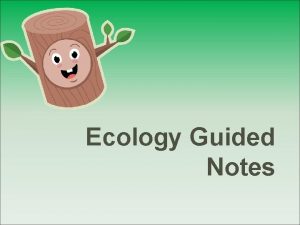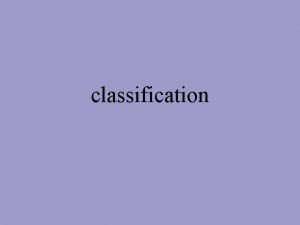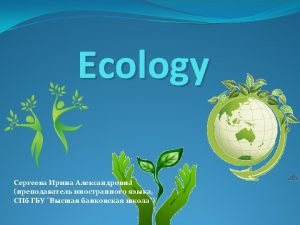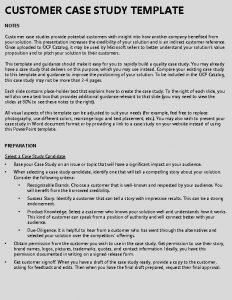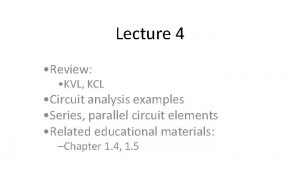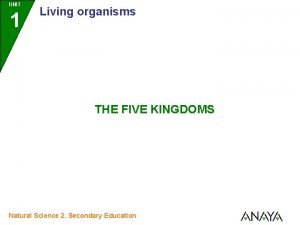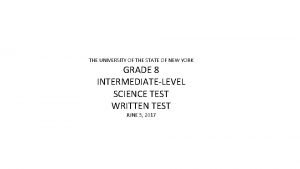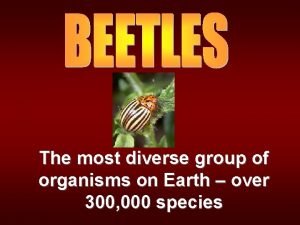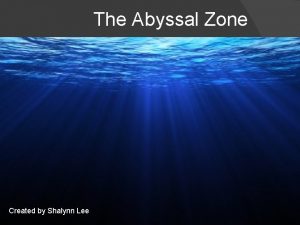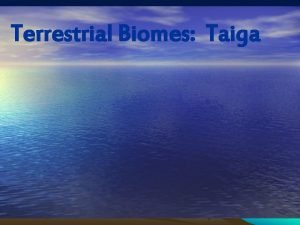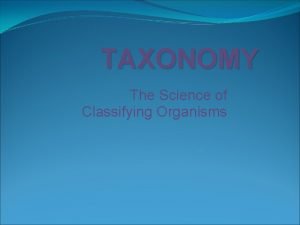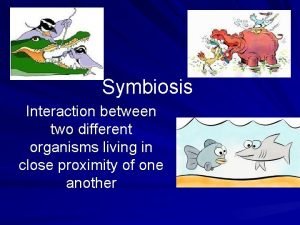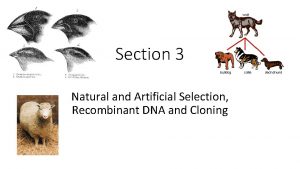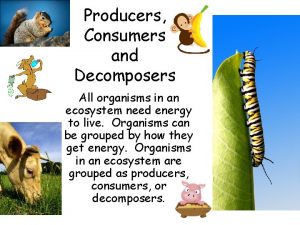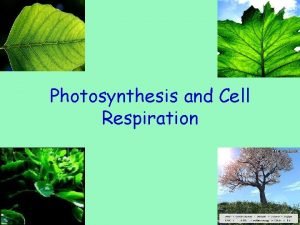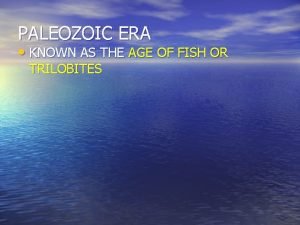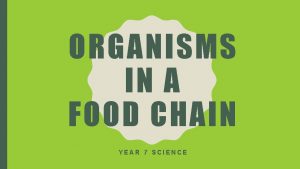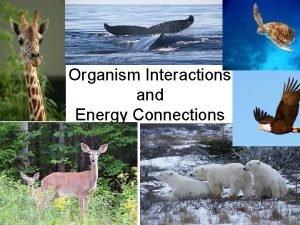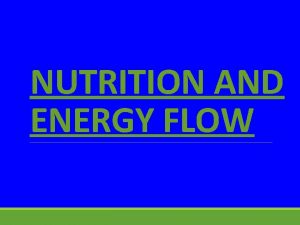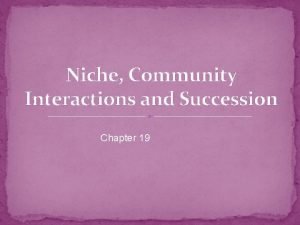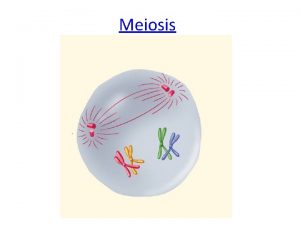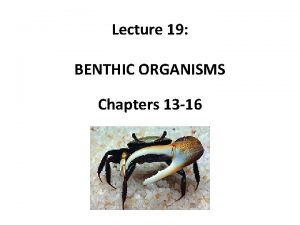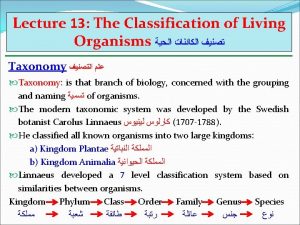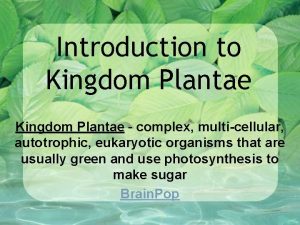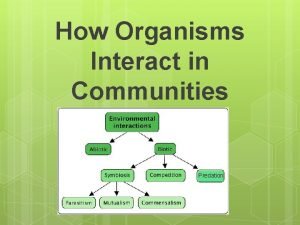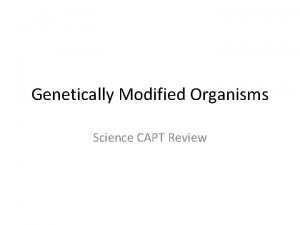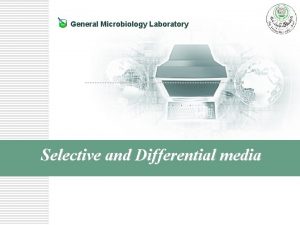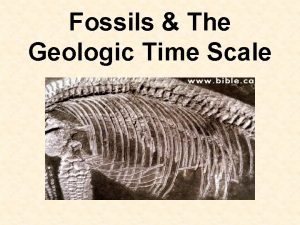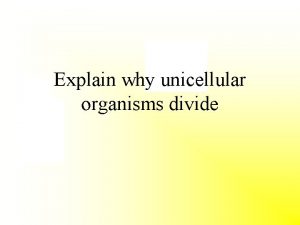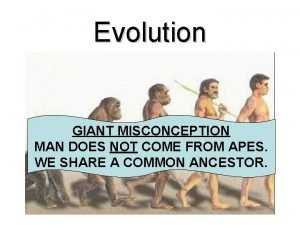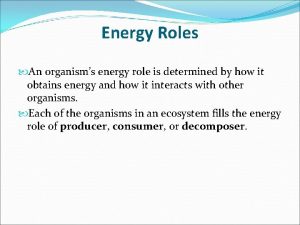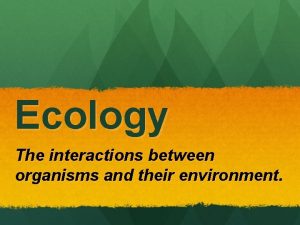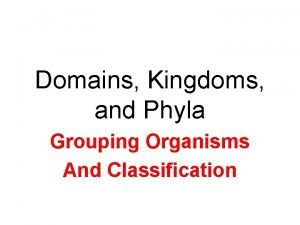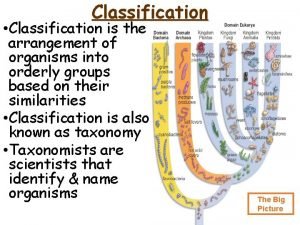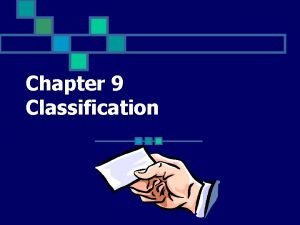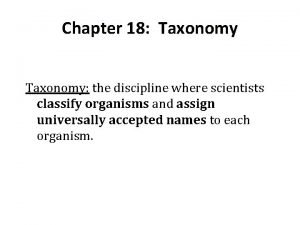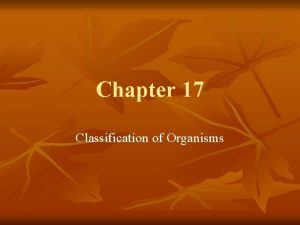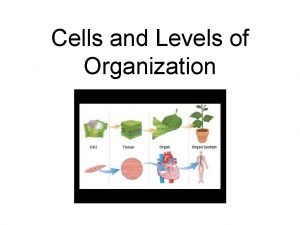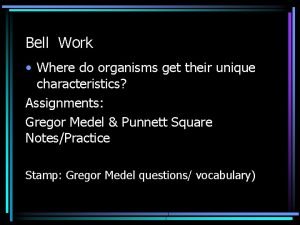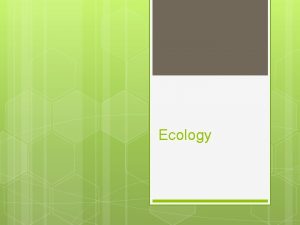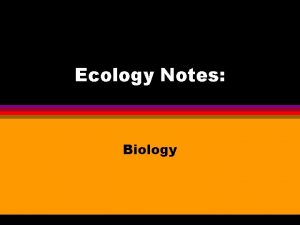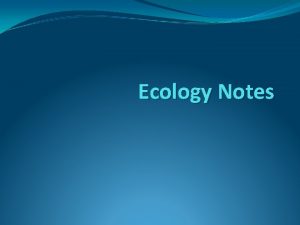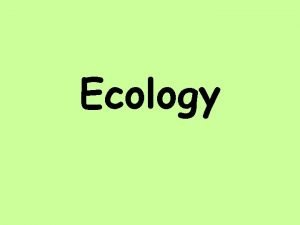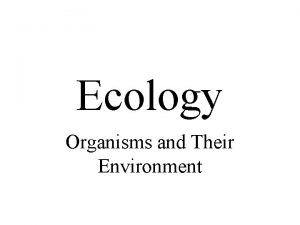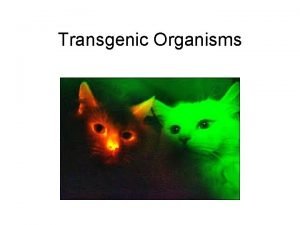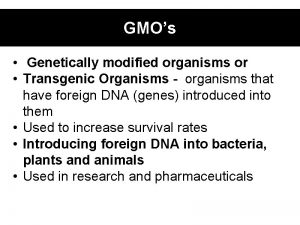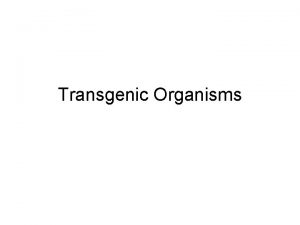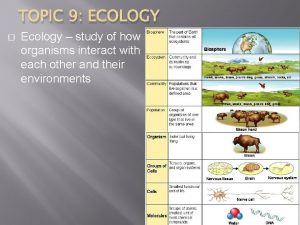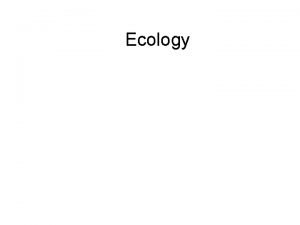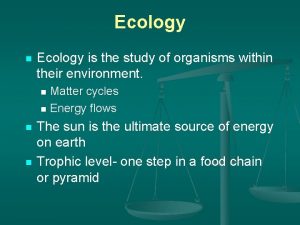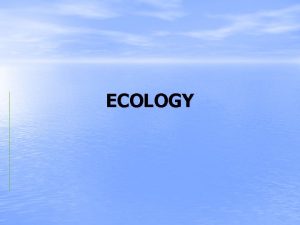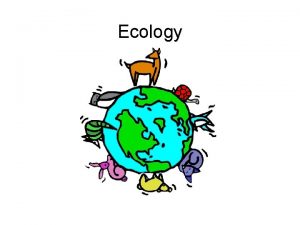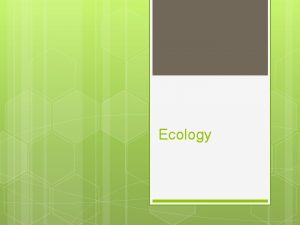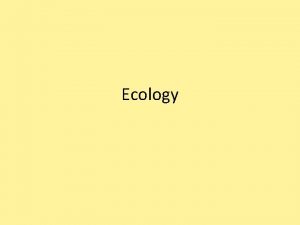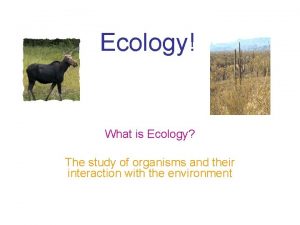Ecology Notes Ecology the study of how organisms




















































































































- Slides: 116


Ecology Notes Ecology - the study of how organisms relate and interact with their environment

Biosphere - the part of earth and the atmosphere where life exists, including land, air, and water. It extends 8 km above the earth’s surface and 11 km below the ocean surface

Ecosystem - area containing organisms interacting with each other and the non-living parts of the environment

Ecosystem cont’d • An ecosystem is self-sufficient. Two requirements are needed! 1. Flow of Energy 2. Material Cycles (Water Cycle, Nitrogen Cycle, Carbon Cycle, etc. )

Community - 2 or more different populations living in the same area • The Ozark Stream in MO……can you think of what this community consists of ? ? ?

The community of Ozark Stream

Population - groups of individuals that belong to the SAME species

Ecosystem Requirements 1. Flow of Energy a. Food Chain - a series of steps in which organisms transfer energy by eating or being eaten Main source of energy Is the SUN!!!!

Producer - capture energy from the sun and make their own food; aka Autotrophs Producers make their own food by…. Photosynthesis CO 2 + H 2 O C 6 H 12 O 6 + O 2 Carbon Dioxide + Water = Carbohydrates + Oxygen Examples - algae, kelp, trees

Consumers - organisms that consume food; aka heterotroph • Examples Herbivore: consumes PLANT only - such as cows, rabbits, caterpillars, and deer

Carnivore: consumes ANIMALS only - such as snakes, dogs, and owls Predator - carnivores that HUNT for food; tigers, wolves Scavenger - carnivores that eat corpses of animals that are already dead or have been killed by another predator

Omnivore - eat BOTH Plants and Animals Such as Bears Decomposers - breakdown organic matter such as bacteria and fungi; recycle Nitrogen back into the ecosystem

Predator or Scavenger? ? ?

Predators or Scavengers? ? ?

Food Web – all the food chains in an ecosystem


Ecological Pyramids - energy or living matter (biomass) can be represented by a triangle

• Conclusion…. . Ecological pyramids show the decreasing amounts of energy, Biomass, or number of organisms at each successive feeding level.

2. Material Cycles - Recycling in the Biosphere a. Water Cycle - water moves between the ocean, atmosphere, and land.


Water cycle cont’d Evaporation - water changes from liquid to gas from bodies of water Transpiration - evaporation of water from the leaves of plants How does transpiration occur? ? ? Transpiration is the evaporation of water from plants. It occurs at the leaves while their stomate are open for the passage of CO 2 and O 2 during photosynthesis


• Stomate

b. Carbon and Oxygen Cycle

Two Major Reactions Involved • Photosynthesis CO 2 + H 2 O • Respiration C 6 H 12 O 6 + O 2 CO 2 + H 2 O +ATP

Note: Stomates play an important role in these reactions in plants. Stomates aid in maintaining homeostasis


Other contributors to this cycle: • Decomposition - the breakdown of dead • • organic matter Burning (combustion) of Fossil Fuels Other human activity such as mining, cutting and burning forests CO 2 released into the atmosphere by volcanoes

Nitrogen Cycle

c. Nitrogen Cycle • N 2 (Nitrogen gas) makes up 78% of the • • • Earth’s atmosphere. Other nitrogen compounds are found in wastes produced by organisms and in decaying matter Human activity such as fertilizing adds nitrogen to the biosphere Decomposers recycle N back into ecosystem

B. Interactions in the Ecosystem • Ecosystems are influenced by the • • combination of biological and physical factors. Biotic Factors: Living things and interactions between living things (population size, competition) Abiotic Factors: Non-living things in an ecosystem (amount of food, water, space)

1. Examples of Interactions • Competition - individuals of a species or different species compete for food, shelter, mates, and space •

Bacteria competing for space

• Niche - the role an organism plays in an ecosystem including feeding habits, where it lives, and it’s reproductive behavior.

Predator/Prey Relationship

b. Predator/Prey Relationship


c. Symbiosis - relationship between individuals of different species • Mutualism - (+, +) both species BENEFIT from the relationship Example: Oxpecker bird eats ticks off the back of a rhino

• 2. Commensalism (+, 0) - one species BENEFITS and the other neither benefits nor is harmed Example: Barnacles and Whales

• Parasitism - (+, -) one organism benefits and the other is harmed Example - ticks and a dog

C. Ecological Succession • How does an ecosystem develop and/or • respond to human or natural disturbances? Ecological Succession – change in an ecosystem in which there is a replacement of one community by another – a slow process of change that can take over 150 years

Primary Succession • Succession that occurs on surfaces where NO soil exists (aka – starting from scratch). Ex. Volcanic eruption forming an island

• Pioneer Organism – very first organism that populates an area Example: Lichen - Moss/Grasses - Shrubs - Coniferous Tree - Deciduous Tree Succession occurs until a climax community is reached Climax Community - a community (plants and animals) that has reached its stable state based on the climate Example: New York - Maple, Oak, Beech, Deer and Squirrels


2. Secondary Succession – Succession that occurs when disturbances change an existing ecosystem (a climax community) • Examples: forest fire, plowing fields, clearing land

D. Biomes - large portion of earth that has a similar climate with similar climax communities: flora (plants) and fauna (animals)

1. Land Biomes • Tundra


TAIGA

Taiga

Deciduous Forest


Grassland



Desert


Tropical Rainforest



Biome Characteristics Flora Fauna Tundra Long Winter: ice snow Short Summer: top layer thaws, wet, 60 day growing season Mosses, Lichens, Grasses Insects, rodents, Arctic fox, caribou Taiga South of tundra; 120 day growing season, Pines, firs, spruce Black bears, moose, squirrels, lynx, insects, birds Deciduous Forest South of Taiga; Cold Winters, Warm Summers, Moderate temperature; 80160 cm rain/yr Beech, Hickory, Oak, Maple Rabbits, mice, chipmunks, raccoons, deer, foxes Grassland 25 -75 cm rain/yr; Cold Winters, Warm Summers Limited to grasses Prairie dogs, antelopes, owls, snakes, badgers Desert Days very hot, nights very cold, less than 25 cm rain/yr Cactuses, sagebrush, yucca Owls, roadrunners, lizards, kangaroo rats, insects Tropical Rainforest Heavy Rain fall, constant broad leafed plants Warmth bamboo, ferns snake, monkey, leopard

E. Human Impact on the Environment 1. Negative Impact a. Human Population Growth: There are currently 6+ billion people on Earth. By 2050, it is estimated that the population will reach 9 billion

Carrying Capacity - the number of individuals (population size) of a species that can be supported by the amount of resources available

Limiting Factors – factors that will limit the population size of a given species • Examples: Food, water, space, oxygen

b. Pollution - depositing harmful materials into the environment 1. Water Pollution: Even though water is a renewable resource, the total supply of fresh water is limited. Common Pollutants: fertilizer, sewage, dredging



Oil Spills – Gulf of Mexico 2010





2. Land Pollution/Waste Disposal Problems: • If managed properly, land is a renewable • resource. Common Pollutants: ammonia, acid rain, garbage, pesticides


Poor land management: Overcropping, Overgrazing, Increased Urbanization • Causes an increased rate of soil erosion

3. Air Pollution: Significant environmental problems are the result of air pollution A. Acid Rain: rain that has mixed with nitric and sulfuric acids Acid Rain is caused by burning fossil fuels such as coal, vehicle exhaust systems

Acid rain can kill plants by damaging their leaves and changing the chemistry in the soils and standing-water ecosystems

Problems from Acid Rain: • Destruction of limestone and • • marble monuments due to increased chemical weathering Acidification of aquatic ecosystems destroying the life in them Damage forests and other plants in a variety of ways





b. Global Warming - an increase in the average temperature on Earth • The 1990’s were the • hottest decade ever recorded Global warming has affected Earth’s ice caps

• Global warming is caused by human • • activity adding CO 2 and other greenhouse gases such as methane to the atmosphere These greenhouse gases hold more heat Burning of fossil fuels, cutting down and burning forests have added CO 2 into the atmosphere faster than the Carbon Cycle can remove it


c. Ozone Layer Depletion: the ozone protects the Earth from the ultraviolet rays of the sun Caused by the release of manmade compounds into the atmosphere. The most common being Chloroflurocarbons (CFCs)

4. Loss of Biodiversity • What is Biodiversity? Variation of life in an ecosystem

How does human impact decrease biodiversity? • Deforestation: cutting down and burning of trees eliminates habitats for many species and decreases amt of CO 2 used by plants and increases amount in the atmosphere




• Forests: are becoming increasingly depleted as a result of timber needs & the need for more agricultural land – the direct harvesting of timber has destroyed many forests – this destruction also impacts land use and atmospheric quality

Land use (includes increasing urbanization and the cultivation of marginal lands) – this decreases the space and resources available to other species

Pesticide usage: chemicals used to kill pests/insects that destroy plants


c. Overhunting/Overfishing


d. Introduction of Invasive Species

– ** Other problems include habitat • destruction, importation of some organisms have caused problems for native organisms. We have alien invasive species which have caused problems for our area in New York. These include the Water Chestnut, Eurasian Water milfoil, Alewife, Zebra Mussel, and Purple Loosestrife.

Purple Loosestrife Plant

Remember the Simpson episode where Bart calls Australia to see which way the toilet flushes? He brings with him a frog and it takes over the country and on the way home, a koala hands on to the Simpson’s helicopter!

e. Exploitation of Organisms


2. Positive Impact • A. Conservation of Natural Resources: natural resources conservation programs help people reduce soil erosion, enhance water supplies, improve water quality, increase wildlife habitat

b. Species Preservation


Species Preservation • Some efforts to sustain endangered species have included habitat protection (wildlife refuges and national parks) and wildlife management (game laws and fisheries). • Animals which were once endangered but are presently successfully reproducing and increasing their numbers are the bison, gray wolves and egrets.

• Endangered animals which are currently • • responding to conservation efforts and beginning to make a comeback are the whooping crane, bald eagle, and peregrine falcon. ** The future of many species remains in doubt. Human activities that degrade ecosystems result in a loss of diversity in the living and nonliving environment. These activities are threatening current global stability.




c. Biological Control

c. Biological controls: • Introduction of natural enemies • (ex. praying mantis) • Use artificial sex hormones to lure insects to their death (pheromones) – (ex. gyplure -- male gypsy moths) • Sterilization and release of male insects – (ex. irradiation of screwworm fly w/cobalt-60) – Note: The screwworm fly only gets to mate once, so she is out of luck if she mates with a sterile male!!

Environmental Laws/Pollution Controls

• ** There are laws which regulate and guide the use of natural habitats. • SEQR (New York's State Environmental Quality Review Act): A New York State law designed to provide the opportunity for citizen review and comment of the environmental impact of any proposed development that has been determined to have significant impact on the environment.
 Why do organisms interact with other organisms
Why do organisms interact with other organisms Multicellular and unicellular organisms
Multicellular and unicellular organisms Organisms ecology
Organisms ecology Principles of ecology chapter 2 section 2 answer key
Principles of ecology chapter 2 section 2 answer key Section 1 organisms and their relationships
Section 1 organisms and their relationships Whats is ecology
Whats is ecology Evolution and community ecology guided notes
Evolution and community ecology guided notes Taxonomy is the science of grouping and naming organisms
Taxonomy is the science of grouping and naming organisms Most general to most specific classification
Most general to most specific classification Biology ecology study guide answer key
Biology ecology study guide answer key Chapter 3 section 1: community ecology
Chapter 3 section 1: community ecology Ecology is the study that helps to preserve
Ecology is the study that helps to preserve Facteur g
Facteur g Hát kết hợp bộ gõ cơ thể
Hát kết hợp bộ gõ cơ thể Frameset trong html5
Frameset trong html5 Bổ thể
Bổ thể Tỉ lệ cơ thể trẻ em
Tỉ lệ cơ thể trẻ em Voi kéo gỗ như thế nào
Voi kéo gỗ như thế nào Tư thế worm breton là gì
Tư thế worm breton là gì Hát lên người ơi alleluia
Hát lên người ơi alleluia Môn thể thao bắt đầu bằng chữ f
Môn thể thao bắt đầu bằng chữ f Thế nào là hệ số cao nhất
Thế nào là hệ số cao nhất Các châu lục và đại dương trên thế giới
Các châu lục và đại dương trên thế giới Công thức tính độ biến thiên đông lượng
Công thức tính độ biến thiên đông lượng Trời xanh đây là của chúng ta thể thơ
Trời xanh đây là của chúng ta thể thơ Mật thư anh em như thể tay chân
Mật thư anh em như thể tay chân Phép trừ bù
Phép trừ bù độ dài liên kết
độ dài liên kết Các châu lục và đại dương trên thế giới
Các châu lục và đại dương trên thế giới Thơ thất ngôn tứ tuyệt đường luật
Thơ thất ngôn tứ tuyệt đường luật Quá trình desamine hóa có thể tạo ra
Quá trình desamine hóa có thể tạo ra Một số thể thơ truyền thống
Một số thể thơ truyền thống Bàn tay mà dây bẩn
Bàn tay mà dây bẩn Vẽ hình chiếu vuông góc của vật thể sau
Vẽ hình chiếu vuông góc của vật thể sau Thế nào là sự mỏi cơ
Thế nào là sự mỏi cơ đặc điểm cơ thể của người tối cổ
đặc điểm cơ thể của người tối cổ Giọng cùng tên là
Giọng cùng tên là Vẽ hình chiếu đứng bằng cạnh của vật thể
Vẽ hình chiếu đứng bằng cạnh của vật thể Phối cảnh
Phối cảnh Thẻ vin
Thẻ vin đại từ thay thế
đại từ thay thế điện thế nghỉ
điện thế nghỉ Tư thế ngồi viết
Tư thế ngồi viết Diễn thế sinh thái là
Diễn thế sinh thái là Dạng đột biến một nhiễm là
Dạng đột biến một nhiễm là Bảng số nguyên tố
Bảng số nguyên tố Tư thế ngồi viết
Tư thế ngồi viết Lời thề hippocrates
Lời thề hippocrates Thiếu nhi thế giới liên hoan
Thiếu nhi thế giới liên hoan ưu thế lai là gì
ưu thế lai là gì Khi nào hổ mẹ dạy hổ con săn mồi
Khi nào hổ mẹ dạy hổ con săn mồi Sự nuôi và dạy con của hổ
Sự nuôi và dạy con của hổ Hệ hô hấp
Hệ hô hấp Từ ngữ thể hiện lòng nhân hậu
Từ ngữ thể hiện lòng nhân hậu Thế nào là mạng điện lắp đặt kiểu nổi
Thế nào là mạng điện lắp đặt kiểu nổi Introduction to linguistics by george yule
Introduction to linguistics by george yule Customer notes template
Customer notes template What is the overall message of romeo and juliet
What is the overall message of romeo and juliet Kvl circuit analysis
Kvl circuit analysis What is case series
What is case series Retrospective cohort study
Retrospective cohort study Process of method study
Process of method study Marty lobdell
Marty lobdell Phytogeographical regions
Phytogeographical regions Distinguish between motion study and time study
Distinguish between motion study and time study Time and motion study example ppt
Time and motion study example ppt What are the five kingdoms of living things
What are the five kingdoms of living things Multicellular organisms
Multicellular organisms Unicellular simple definition
Unicellular simple definition Which principle
Which principle Most diverse group of organisms
Most diverse group of organisms The zone of lake with perpetual darkness
The zone of lake with perpetual darkness Boreal forest precipitation
Boreal forest precipitation Is the science of naming and classifying organisms
Is the science of naming and classifying organisms Organisms taxonomy
Organisms taxonomy Guinea worm
Guinea worm Artificial selection
Artificial selection Eucariote
Eucariote What is consumer
What is consumer Parts of photosynthesis
Parts of photosynthesis Pangea paleozoic era
Pangea paleozoic era Moth food chain
Moth food chain What do the arrows on a food web represent
What do the arrows on a food web represent How do organisms obtain energy
How do organisms obtain energy What is an organisms niche
What is an organisms niche Muddy shores
Muddy shores Microbiology chapter 7 microbial growth
Microbiology chapter 7 microbial growth Chromosomes form tetrads during
Chromosomes form tetrads during Venn diagram of living things and nonliving things
Venn diagram of living things and nonliving things Intertidal zone
Intertidal zone Organisms taxonomy
Organisms taxonomy A multicellular autotrophic organism with vascular tissue
A multicellular autotrophic organism with vascular tissue Example of coevolution
Example of coevolution Genetically modified organisms
Genetically modified organisms Differential media vs selective media
Differential media vs selective media Quaternary period organisms
Quaternary period organisms Food chains are interconnecting food webs
Food chains are interconnecting food webs Why unicellular organisms divide
Why unicellular organisms divide Simple to complex organisms
Simple to complex organisms What is this
What is this How is an organism’s energy role determined?
How is an organism’s energy role determined? Organisms and the environment
Organisms and the environment Biotic
Biotic 3 domain 6 kingdom
3 domain 6 kingdom Prokaryotic vs eukaryotic cells
Prokaryotic vs eukaryotic cells Classification arrangement
Classification arrangement Are all living things based on the metric system
Are all living things based on the metric system Most general to most specific classification
Most general to most specific classification Genetically modified organisms
Genetically modified organisms Principles of ecology section 3 cycling of matter
Principles of ecology section 3 cycling of matter Principles of ecology section 2 flow of energy
Principles of ecology section 2 flow of energy Principles of ecology chapter 2
Principles of ecology chapter 2 The scientific discipline of classifying organisms
The scientific discipline of classifying organisms 8 major levels of classification
8 major levels of classification Simple to complex organisms
Simple to complex organisms Taxonomy in biology
Taxonomy in biology Where do organisms get their traits?
Where do organisms get their traits?





